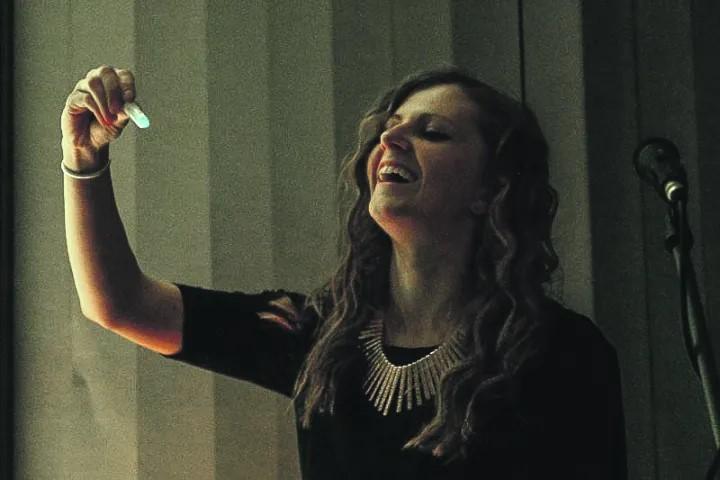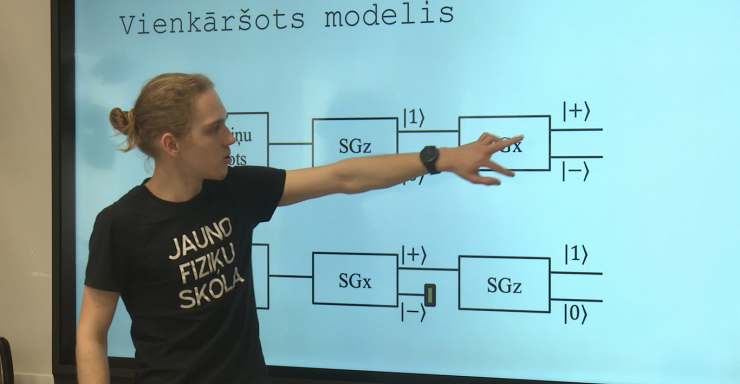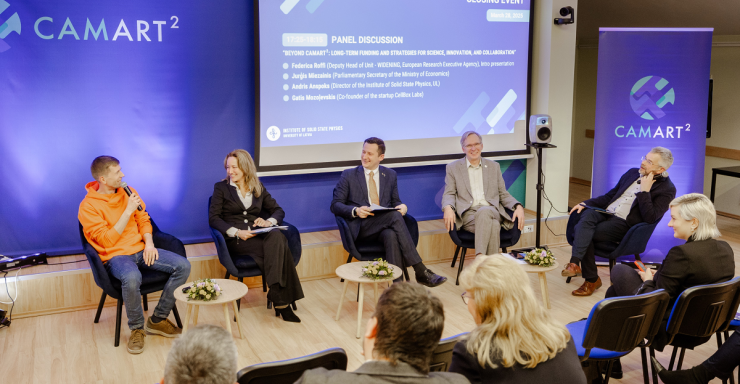With determination and perseverance, almost anything is possible, and this is demonstrated by Virginia Vītola, who, after graduating from a high school with a humanities focus, chose to study physics and mathematics. Furthermore, before turning 30, she had already become a doctor of physics, inspiring many young people by her example. On weekdays, Virginia lives in Riga, but, like in her childhood, she spends most of her weekends in Lielvārde, where her parents still live.

Virginia Vītola earned her doctoral degree in materials physics in 2019, at the age of just 29, defending her research on the afterglow mechanism of luminescent, long-lasting materials at low temperatures. A year later, in 2020, she received the Latvian Academy of Sciences’ Young Scientist Award, which was granted to her for her doctoral work “Electronic Excitations and Processes in the Luminescent Long-Lasting SrAl2O4 Material”. This topic had also been the focus of her bachelor's and master's theses.
For her research, Virginia has also received various accolades, including the Werner von Siemens Excellence Award for her master's thesis, a scholarship from the company A/S Sidrabe, and was part of the team that received recognition from the Latvian Academy of Sciences for one of the most significant achievements in Latvian science in 2018 for the study “A New Energy-Efficient Method for Producing Long-Lasting Coatings on Metals”.
Currently, at the age of 34, Virginia is not only the lead researcher at the Optics Materials Laboratory at the Institute of Solid-State Physics at the University of Latvia, but she also works at the RTU Engineering High School, teaching physics. Many students, inspired by Virginia, may choose to become scientists themselves.
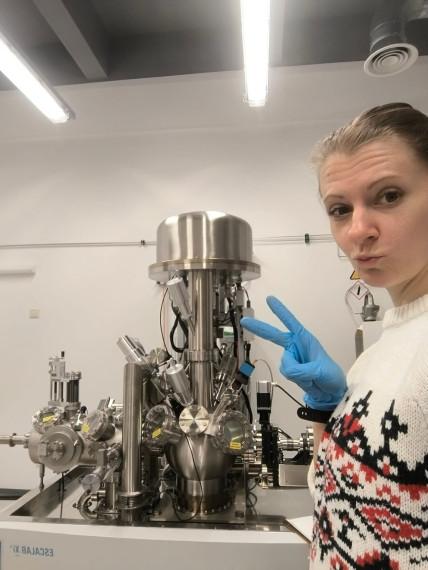
Parents as Artists, Daughter as a Physicist
It is common for outstanding scientists to have spent their childhood in environments where exact sciences are highly valued, but Virginia grew up in an artist family. Both of her parents graduated from the Latvian Academy of Arts. Her mother, Ināra Liepiņa, works in magazine layout and also draws illustrations, while her father, Agris Liepiņš, is a well-known cartoonist and, until recently, the owner of the ancient Latvian wooden castle. The only person in the family with a connection to exact sciences was her grandmother, Zaiga Liepiņa, who lived in Lielvārde and has since passed away. Zaiga was a road construction engineer.
Virginia recalls that during her childhood, the family lived in an apartment in Riga during the weekdays, but their house was in Lielvārde, and on Friday afternoons, they would all board the train to Lielvārde to build a castle.
"This is a place that was very close and dear to me in my childhood. I truly hope that the Ogre municipality, which bought this castle from my parents, will continue to develop it further. It was clear that if anyone from our family wanted to continue working with the castle, it would mean putting an end to their own career. But both my sister and I have invested a lot in our careers, and we couldn’t maintain the castle without sacrificing something. Our parents can no longer do it due to health reasons. It is definitely better that the Ogre municipality takes over and continues this work. The amount of work my parents invested in this castle is beyond words, they spent all their weekends there. Losing all of that would be painful. Those are also my childhood memories,” says Virginia.
When her parents retired, they moved to Lielvārde, but Virginia, along with her four-year-old daughter, lives in Riga for work. Virginia graduated from the Riga Centre Humanities High School, where she studied languages and literature in depth. At that time, she had no interest or knowledge in physics or mathematics. Her sister, Lelde, also studied in the humanities stream and became a translator, but now, together with her husband Jānis Kaibals, manages the "Lūšu Drava" beekeeping farm. Virginia thought she, too, would continue along the humanities path, but everything changed in high school when she met a wonderful physics teacher and, while singing in the physics and mathematics choir, met people with similar ways of thinking. The scientist admits that the first few years were very difficult.
"In our school, we had about seven literature classes a week – English literature, foreign literature, and Latvian literature. We had to read a lot and memorize things by heart. My parents were surprised when I told them I chose to study physics and mathematics, but they allowed me to make my own decision. When I started studying physics and mathematics, I realized that with the approach I had used in the humanities subjects, I wouldn’t get very far. You need to have understanding. The first few years, restructuring my way of thinking wasn’t easy, but I managed, overcame all difficulties, and can happily live the life of a scientist,” Virginia recalls with a smile, adding that now, while teaching at the RTU Engineering High School, she tells her students that with a physics and mathematics education, one can work not only in science but also in many other fields – seeking any place where such knowledge is in demand. It could be the finance sector, various institutions where structured, reasoned thinking is needed.

Interest in Exact Sciences Should Be Fostered from Childhood
"I am fortunate to teach young people who have already demonstrated their interest in exact sciences, but when I go to the Young Physicists' School, it’s important to explain what this education offers, how it helps in the job market, and how it can lead to earning a living. I tell them about the various ways they can build their careers with this type of education, but when talking about natural and exact sciences in general, it all starts in families. In my opinion, parents shouldn’t just give their children a phone or a computer, but should talk to them more, point out various phenomena in nature. At least that’s what I try to do with my daughter," says Virginia.
“Three or four years old is the age when you can start talking to children, take them to a club, but even at home, you can offer the basics of Lego robotics. We’ve bought a microscope, and we look at things and work diligently with it. Whether I’ll manage to spark her interest in these things, of course, time will tell,” she adds.
On April 23, she will go to the Ogre Gymnasium as an expert to evaluate students' project work and will gladly share her experience, encouraging young people not to be afraid to choose a path in science. “Yes, it’s difficult at first, but it’s just like playing a team sport—it's hard to run, but the enthusiasm makes you forget that it’s hard. Also, when studying exact sciences, it’s so interesting that you forget about the difficulties,” says the scientist, who started working at the University of Latvia's Institute of Solid-State Physics while still in 11th grade—she went to try writing her own research paper and stayed there until she earned her master's degree. Afterward, she worked for a while in the industry at the company Sidrabe, which manufactures large equipment for coating applications, but realized that the freedom and creativity offered by science was what she truly enjoyed.
Currently, Virginia is the leading researcher at the Optics Materials Laboratory at the Institute of Solid-State Physics. As the name suggests, these materials are those that glow, emit light, and interact. Many of the scientist’s previous works were dedicated to luminescent materials that are illuminated with light and then glow at night. “We are also looking at other materials. Together with a colleague, we study a material illuminated by light, which later emits light when pressed, and we can make various sensors from it. Additionally, our colleagues in the laboratory have created a buoy using optical methods—shining and sensing light—to monitor water quality near the shore. Then there’s electroluminescence, where materials glow when electricity is applied. We can make beautiful arc panels,” the scientist explains enthusiastically, adding that her current project involves working with polymers into which silver or other nanoparticles are inserted. These nanoparticles absorb light, heat up, and, for example, if the polymer is in a coiled form, it returns to its original shape when light is shone on it. “This could be used in micro-robots, where it’s impossible to bring electricity to the robot’s arm, but the gripping function could be implemented by shining light on it, and the robot would close its arm,” explains the lead researcher.
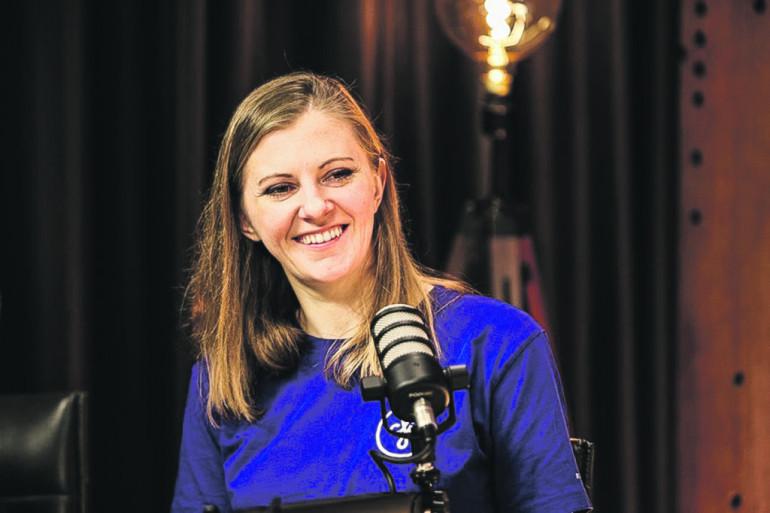
Science Offers Freedom and Creativity
When asked what attracts her most to the work of a scientist, Virginia admits that it is, first and foremost, the freedom of action and creativity. “You constantly need to motivate yourself and figure out what to research. There’s no one main person telling you what to do, especially once you’ve reached a doctoral degree and taken on the role of lead researcher. You have to think for yourself about what the next research topic will be. Of course, it often happens that you try to investigate something, but it doesn’t lead anywhere. Or, sometimes, I propose a project idea to the European Union or the Latvian Science Council, and they reject it, which makes you reconsider your life. Still, this work is very exciting. A scientist also has to talk about their work, and you can go to different conferences, meet with other scientists, and discuss what else can be researched.”
As she mentions, in this garden of roses, a small thorn might be that you constantly have to motivate yourself. “The positive feedback from others helps to maintain the motivation at the necessary level,” says Virginia, adding that the work of a scientist is not just theoretical; it also has practical applications. Scientists look for collaboration partners—various companies—and study topics that could be useful to them. Virginia admits that, in fact, these are the daily goals—researching things that might be useful not in a hundred years but in the near future, so that the research can reach people soon and the technologies developed in the research can be applied in real-life products.
“This is exactly what the Institute of Solid-State Physics offers. Some of the European projects we work on are directly practical research. The last one we submitted was a project to study anti-fog coatings for glass, in collaboration with a company. This time, the project wasn’t approved, but I’m sure it will be evaluated positively at some point,” Virginia shares details of her daily work. In her free time, she takes a break from science by playing football with friends on Sundays. However, free time is scarce. Virginia admits that experiments often take place in a dark room, and she usually heads home when the sun is already setting, so she tries to make the most of every opportunity to spend time with her daughter. Both of them enjoy being in nature, for example, sitting by the Daugava River and watching the flow of the water.

When asked where she sees herself in 20 years, Virginia says that her dream is to one day leave Riga and actually live in Lielvārde, working in schools. “Maybe that’s what I want, but it’s still a long way to go. If the situation allows, I could trade the hectic life in Riga for life in a small town. Right now, there’s a lot of work, and life is fast-paced—between work in the laboratory, with students, and young people. In fact, I would like to work in a way that the young people I teach could look up to me as an example.”
“It would be wonderful if I could inspire my students to become scientists or professionals in some exact science fields, and if I had a part in that,” says Virginia Vītola, smiling.
